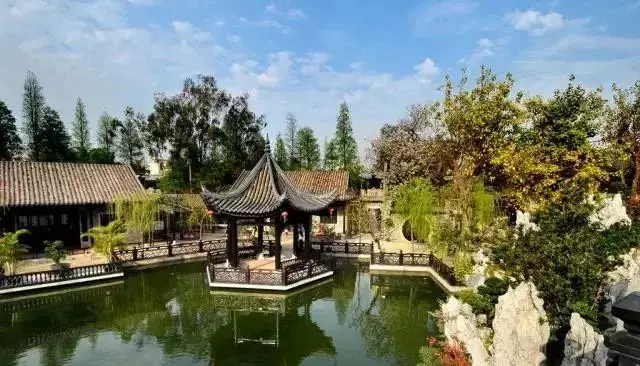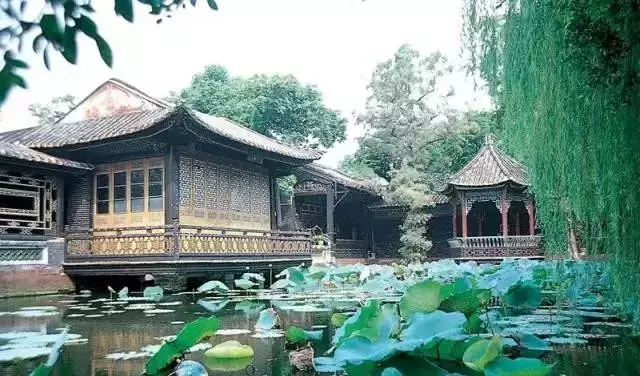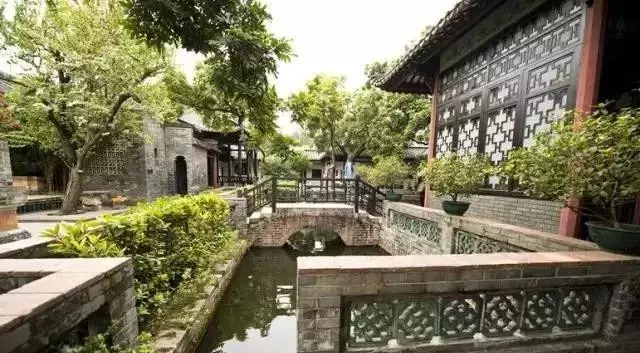Poetic ancient gardens in GD
Recently, the Chinese historical drama “Story of Yanxi Palace” went viral online, shattering viewership records. Set during the Qing Dynasty (1644-1911), the show follows the story of an imperial court maid who manages to become one of the Emperor Qianlong’s favorite concubines.
The drama, with its intricate settings and delicate costumes all based on historical fact, has probably piqued your interest, making you wish you could travel back in time to the era of the drama to experience it for yourself. The good news is that you can experience the ancient charm of the Qing Dynasty in the poetic gardens in Guangdong.
Yu Yam Ancestral Garden in Panyu

Yu Yin Shan Fang, also called Yu Yam Ancestral Garden, is located on North Street in Nancun Town, Panyu District, Guangzhou. It was first built in 1864, the third year in the reign of Emperor Tongzhi in the Qing Dynasty, and enjoys a history of over 150 years.
Yu Yam Ancestral Garden is one of the four most famous gardens from the Qing Dynasty in Guangdong Province. The other three are Foshan Liang’s Garden, Dongguan Ke Garden and Shunde Qinghui Garden.
Covering an area of 1,598 square meters, the garden was the private residence of Wu Yantian. The father and his two sons scored among the top three in different national imperial examinations taken by the literati class at the time. With an ingenious layout, the garden houses pavilions, terraces, halls, bridges, lakes and hills. The exquisite style of the garden can be seen by the large variety of brick, wood, lime and stone carvings.
Add: North Street, Nancun Town, Panyu District, Guangzhou 广州市番禺区南村镇北大街
Tickets: 18 yuan; half price for students
Transport: Take a train from Shenzhen North Railway Station to Guangzhou South Railway Station, then take Metro Line 7 to Banqiao Station, take Exit A and walk to the destination.
Qinghui Garden in Shunde

Located in Shunde District, Foshan, Qinghui Garden was built in the last period of the Ming Dynasty (1368-1644). It is one of the 10 best gardens in China and one of the four most famous gardens in Guangdong as well. It is a Lingnan-style garden featuring architectural characteristics known for belonging to traditional southern China.
Qinghui Garden was firstly built by Huang Shijun, who was ranked the No.1 scholar in the late Ming Dynasty imperial examination. The existing buildings in the garden were mainly built during the reign of Emperor Jiaqing (1796-1820) of the Qing Dynasty.
The yard, buildings, ponds and decorative boulders fit with each other in a harmonious way. Buildings in Qinghui Garden are set in deliberate and picturesque order to highlight the water. Wooden or ceramic sculptures and colorful glassware can be seen everywhere throughout the garden.
Add: Qinghui Road, Daliang Town, Shunde District, Foshan 佛山市顺德区大良镇清晖路
Tickets: 15 yuan; free for local residents
Hours: 8 a.m.-6 p.m.
Transport: Take a train from Shenzhen East Railway Station to Foshan Railway Station, and then take Bus Travel Line 4 to Qinghui Garden.
Foshan Liang’s Garden

One of the four famous gardens in Guangdong, Liang’s Garden is located in Foshan. It is a traditional private garden belonging to the Liang family. The builders were a handful of the clan’s uncles and nephews: Liang Airu, Liang Jiuzhang, Liang Jiuhua and Liang Jiutu.
The garden was first built in 1796 during the Qing Dynasty and carefully built over a period of 40 years. In the early Republic of China period (about 1912), the garden was nearly destroyed. The existing part is only one fifth of the original.
Liang’s Garden features delicate configurations and complex residences, ancestral halls and diversified parks in Lingnan style, presenting an elegant pattern. The garden also houses the works of famous calligraphers from throughout history.
With history, cultural significance and a wonderful sense of serenity, Liang’s Garden is a great oasis within a busy city.
Add: No. 93, Xianfeng Gu Dao, Songfeng Road, Chancheng District, Foshan 佛山市禅城区松风路先锋古道93号
Tickets: 10 yuan; free on Saturday but visitors need to show their ID card
Hours: 9 a.m. - 5 p.m.
Transport: Take a train from Shenzhen North Railway Station to Foshan West Railway Station, then take Bus G12 to Xugong Hotel and walk to the destination.
Ke Garden in Dongguan

Originally built in 1850, the 30th year of the reign of Emperor Daoguang in the Qing Dynasty, Ke Garden was built with blue bricks by Zhang Jingxiu, a deposed military officer. Predecessors praised it as “a blessed place on earth, a garden comparable to a fairyland.” The garden is also one of the four most famous gardens from the Qing Dynasty in Guangdong Province.
Covering an area of 2,204 square meters, the garden is not large, but it is exquisite and enjoyable by artistically combining living rooms, bedrooms, gardens, villas, yards, studies, corridors and pavilions.
The garden is home to dozens of traditional buildings, pavilions, ponds, bridges, halls and rooms. The whole complex was built with wood and bricks, with delicate and elegant carvings on the windows, doors and handrails.
Nestled against a mountain, the garden is endowed with fresh air. Walking inside, you will be embraced by the sweet fragrance of osmanthus basically everywhere. Like other gardens in South China, the buildings, the flowers, the hills and the lakes in the Ke Garden blend with the surroundings harmoniously.
Add: No. 32, Keyuan Road, Guancheng, Dongguan 东莞市莞城可园路32号
Tickets: 8 yuan
Hours: 9 a.m.-5:30 p.m.; closed on Tuesdays
Transport: Take a train from Shenzhen Railway Station to Dongguan Railway Station, then take Metro Line 2 to Qifeng Park Station. Transfer to Line x6 and get off at Ke Garden (Keyuan).
Baomo Garden in Guangzhou

Built at the end of the Qing Dynasty, Baomo Garden was an extension of the Temple of Lord Bao Zheng located to the east of the garden. The garden now covers an area of 168 mu (100,000 square meters).
Bao was a government officer during the reign of Emperor Renzong in the Song Dynasty (960-1279). During his 25 years in civil service, Bao consistently demonstrated extreme honesty and uprightness through his actions, such as sentencing his own uncle to prison, impeaching an uncle of Emperor Renzong’s favorite concubine and punishing powerful families.
The original garden was destroyed in the 1950s. Reconstruction work began in 1955 and lasted for eight years. After four phases of construction, the garden has been turned into an exemplar South China garden featuring Lord Bao’s heritages, ancient Lingnan architecture, and the familiar and picturesque features of a Pearl River Delta water town.
There is a splendid water scenery inside the verdant garden. Lijing Bay, Qingping Lake and Baomo Lake all connect with the 1,000-meter river. The water here is as crystal-clear as a mirror.
The garden houses an array of art works including pottery sculptures, porcelain sculptures, brick sculptures, stone carvings and wood carvings, which can be seen everywhere. Among them, the most amazing piece is the porcelain inverse relief “Qingming Festival by the Riverside,” which has been added to the Guinness Book of World Records. The bronze statue of Confucius is exhibited in the Treasure Pavilion on Litchi Island for visitors to worship.
Add: Zini Village, Shawan Town, Panyu District, Guangzhou 广州市番禺区沙湾镇紫坭村
Tickets: 40 yuan
Hours: 8:30 a.m.-5:30 p.m.
Transport: Take a high-speed train from Shenzhen North Railway Station to Guangzhou South Railway Station. Then take Metro Line 7 to Hanxi Changlong Station, and transfer to Metro Line 3 to Shiqiao Station. Go out at Exit B, and then take bus Pan 67 from Baiyue Square West to Baomo Garden terminal.